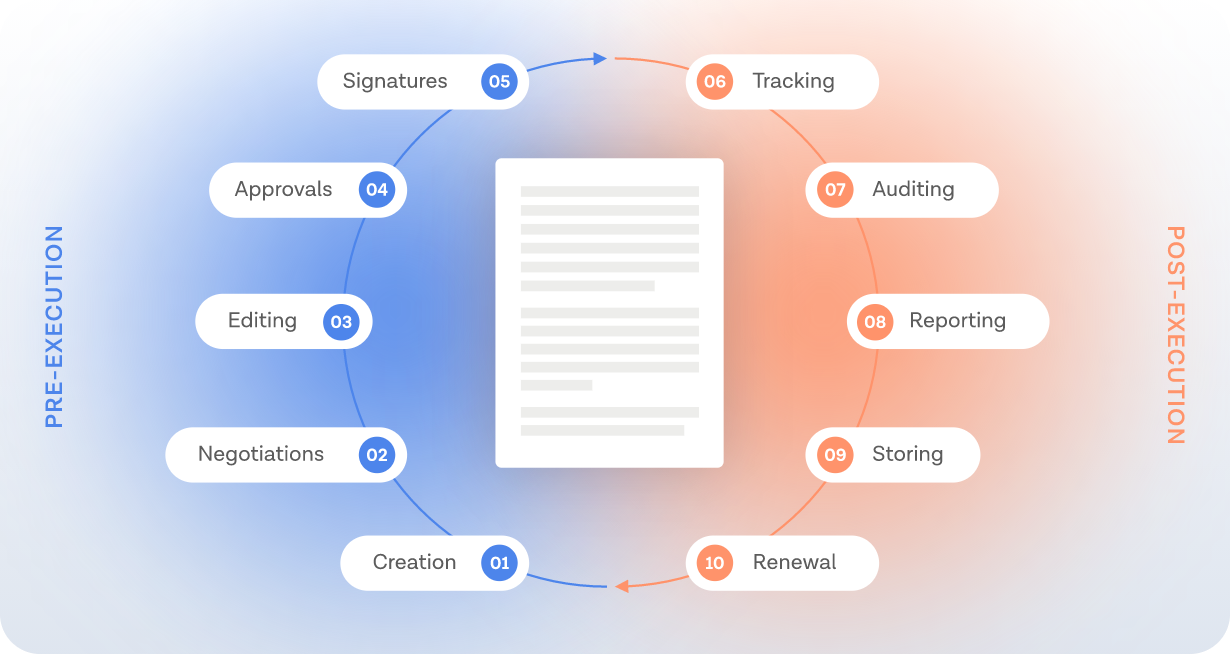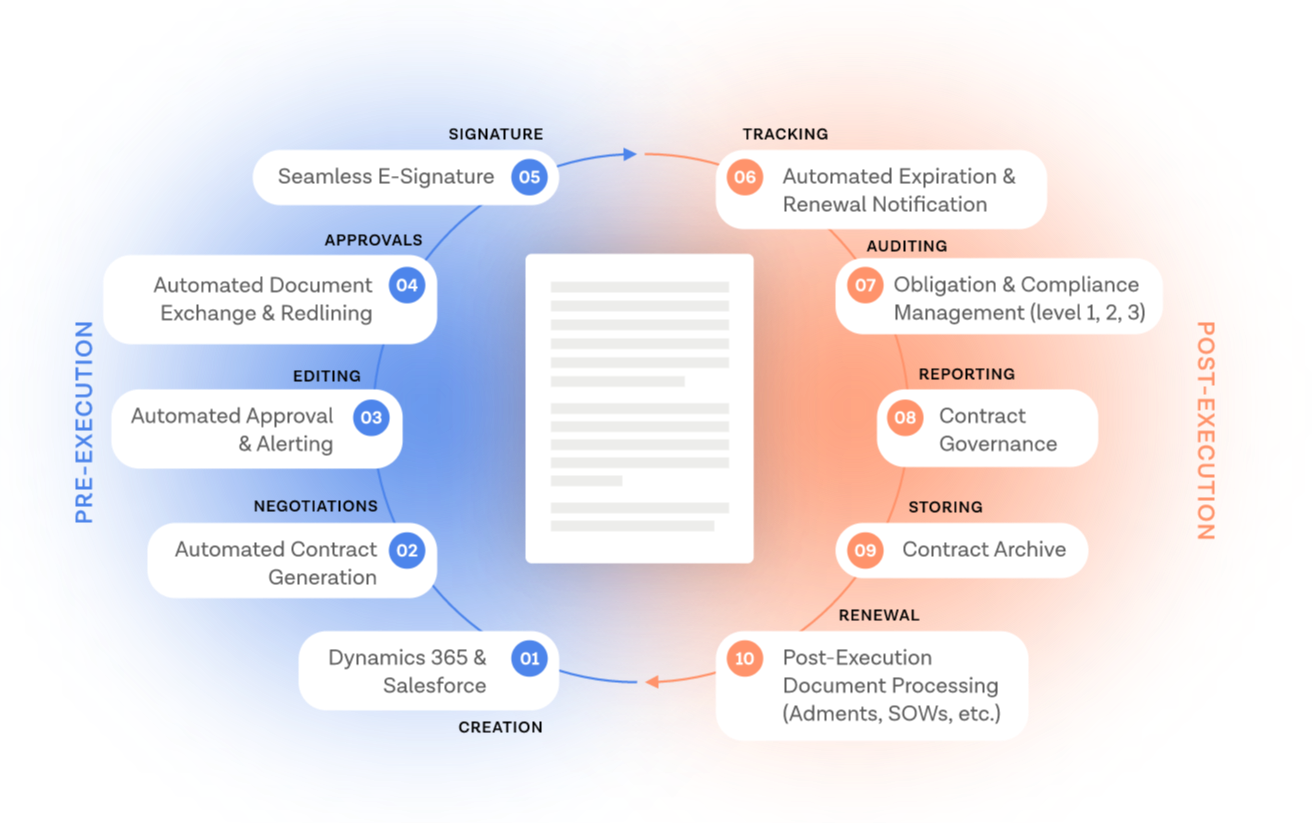Understanding contract management.
Learn why contracts matter and how you can use contract management software to find efficiencies throughout the contract management lifecycle.
Does contract management really matter?

Yes. In fact, contract management matters a lot. According to World Commerce & Contracting, roughly 9.2% of gross revenue is lost on poor contracting processes.1 Think about that. Nearly 10¢ of every dollar a business earns is erased simply because contracts are not properly managed. How can that be?
Well, put simply, contracts are the currency of business. Yes, in the dollars-and-cents sense—just ask any vendor who has tried to get a purchase order without a Master Services Agreement in place. But, at the same time, contracts are what allow collaborators to collaborate (Nondisclosure Agreements). They make it possible to make things (Suppliers Agreements). Contracts let you sell things (Sales Contracts). They enable you to hire qualified people (Employee Agreements) and then protect you if and when those people leave (Noncompete Agreements). They help you find a place to do business (Property Services Agreements) or build something for yourself (Construction Agreements). From the big idea (Joint Venture Agreements) to the big payoff (License Agreements) and everything in between (Subcontractor Agreements, Capital Investment Agreements, and Distribution Agreements, oh, my!) just about everything in business starts with a signed contract.
That’s why contract management matters. So, logically, the software you use to manage your contracts matters, too. After all, your business is riding on every contract you negotiate, sign, store, and renew. And the more efficiently you can create, edit, approve, and manage them, the better you can unlock value, seize opportunities, stay protected, make money, and make a difference.
That’s what we call “the power of contracts.” So let’s dig in.
1. Source: https://www.worldcc.com/Learn/Workshops/Post-Award-Excellence
What is a contract?

In the purest sense, a contract is a written or spoken agreement between two or more people or parties. Contracts typically involve obligations that each party is bound to, and those obligations are enforceable by law. Contracts outline the terms and conditions of your relationship, they stipulate the goods and services to be delivered, payment terms, what happens in the event that something goes sideways, and things you need to do on an ongoing basis.
The most basic elements of a legal contract include:
Mutual assent – Both parties agree to the terms of the arrangement.
Offer – One party invites the other party into an agreement.
Acceptance – The other party signifies their assent or approval of the terms.
Adequate consideration – The exchange, payment, or fulfillment of the agreement must be fair given the nature of the agreement.
Capacity – Both parties must be able to satisfy or deliver what is set out in the agreement.
Legality – The exchange must be lawful.
What are the types of business contracts?

Thomas Watson Sr., former chairman and CEO of IBM, famously said, “Nothing happens until someone sells something.” Maybe this is why the two main types of contracts in business are called Buy Side Contracts and Sell Side Contracts.
What are Sell Side Contracts?
Sell Side, as the name suggests, is predominately used by the Sales Team as part of the sales process. Sell Side Contracts outline the conditions under which an organization offers its goods and services, the associated deliverables, and the payment terms. These contracts provide certain protections to their buyers, such as warranties, while also ensuring that the risks to their organizations are in line with the consideration.
What are Buy Side Contracts?
Buy Side, also as the name suggests, is used by Procurement to buy goods and services on behalf of the organization. Similar to Sell Side Contracts, they detail the goods and services to be purchased. as well as the terms and conditions under which the purchase is made. Buy Side Contracts often include provisions to protect the buyers from risk, aggregate their spending, and ensure that the obligations made by the seller in the contract—or deliverables promised—are met.
More likely than not, your company cares tremendously about both Buy Side and Sell Side contracts, though most organizations tend to be weighted in favor of one over the other. Of course, there’s lots more to contracting than just buying or selling, but this is where a significant amount of contract activity takes place. It also shows why, as we’ll see, the Sales Department and Procurement are such important stakeholders in the contract management process.
BUSINESS CONTRACT: A FEW EXAMPLES
Buy Side
- Agency Agreement
- Business Associate Agreement
- Clinical Trial Agreement
- Confidentiality (Non-Disclosure) Agreement
- Consulting Agreement
- Equipment Purchase Agreement
- License Agreement
- SaaS Agreement
- Settlement Agreement
- Staff Augmentation Agreement
- Subcontractor Agreement
- Supplier Master Services Agreement
Sell Side
- Confidentiality (Non-Disclosure) Agreement
- Customer Master Services Agreement
- Equipment Sales Agreement
- Framework Agreement
- Settlement Agreement
- License Agreement
- SaaS Agreement
Other types of business contracts
Employment
- Employment Agreement
- Employment Services
- Separation Agreement
Real Estate
- Property Mgmt. Agreement
- Property Services Agreement
- Rights of Way and Easement Agreement
Distribution & Partnerships
- Alliance Agreement
- Capital Investment Agreement
- Distribution Agreement
- Royalty Agreement
Corporate
- Banking Services
- Capital Investment Agreement
- Joint Venture Agreement
What is the contract lifecycle?

Once upon a time contracts were written on paper, signed in ink, and stored in a filing cabinet, often under lock and key, for safekeeping. There they sat. And, in truth, many contracts still do. But the world is an increasingly digital place. Today contracts are more often created, signed, and stored electronically.
By pulling the contract out of a stagnant filing cabinet and into the world of databases, cloud repositories, workflows, and analytics, business organizations have gained a powerful opportunity to find efficiencies, increase visibility and oversight, be more proactive and responsive, and gain new insights into their business. Suddenly, contracts are dynamic things that can be managed more effectively at every point along their lifecycle.
What is Contract Lifecycle Management?
Contract Lifecycle Management (CLM) is the science of finding efficiencies, and building new capabilities, at every step of the contracting process—to help reduce risk, increase compliance, and close deals faster, allowing companies to collect cash more readily and recognize revenue more quickly. To understand where efficiencies, and inefficiencies, can occur, it’s helpful to see the contract lifecycle as a two-stage process, Pre-execution and Post-execution.
THE CONTRACT LIFECYCLE
Pre-execution
- The lifecycle begins with the creation of a contract, a request for a contract, or contract review. It progresses through negotiation, editing, and approvals until the parties arrive at agreement, sign the documents, and execute the contract.
Post-execution
- Once signed, important contract terms are identified to manage contract termination dates, spending, compliance, obligations, and more. The document is then securely stored. When the contract nears the end of its terms, notifications are sent, and auto-renewals activated.
Who are the key stakeholders in the contract management process?

Contracts are handled by different people for different reasons. To help you see the big picture, you should select a team from legal, sales and procurement, management, and information technology.
Legal
Contracts are legal documents that require careful compliance, oversight, and management. This is why contract management software decisions are typically driven by an organization’s Legal Department. Legal often shoulders the heaviest burden when processing contracts—and they quickly see the efficiencies gained and process improvements that result from the proper use of contract management software.

“The Contracts 365 solution provides all of our stakeholders with the immediate transparency they need; it has freed up the Contracts Team to focus on processing more requests and priority tasks. In some cases, what used to take us weeks to handle now requires a few days.”
Mark, Purchasing & Contract Administration Supervisor
CHELAN P.U.D.
Sales & Procurement
It is important to remember, contracts are the currency of business. They are the foundation of everything an organization builds, and they enable or restrict nearly every action it takes. Buying, selling, collaborating—these all depend on contracts. It’s easy to see why contracts and bottlenecks are often considered inseparable.
Therefore it is critical, if not paramount, for other departments, like Sales and Procurement, to be not just involved in the contract lifecycle management process—they must be invested in its success. For instance, consider how important it will be for contract management software to easily integrate with their sales and CRM tools, like Salesforce and Microsoft Dynamics 365— the places where your sales teams live, day in and day out. When sales, procurement, and legal teams are aligned, business velocity can increase dramatically.
Management
Contract terms often include important information around pricing, deliverables, service level agreements, deadlines, obligations, and more. They are the cornerstone of your business—and represent both opportunity and risk to your organization. Executive Teams, Business Managers, and Human Resources should all be considered important stakeholders in contract management decisions.
Information Technology
Finally (or maybe saving the most important for last) IT plays an essential role in all software and technology decisions, implementation, and ongoing support. It’s important to consider, how easily will systems integrate? How will software security be ensured? How will contract data be protected? Where does data reside? Who gets to control it? How easy will it be to train and support users across the company? These are the things that keep IT professionals up at night, and they can make or break a software implementation.
What is Contract Management Software?
THE BIG PICTURE: OVERALL BENEFITS OF CONTRACT MANAGEMENT SOFTWARE

Self-service functionality improves user adoption, ongoing ease of use and customer delight.
Contract and data find-ability and reporting for organizational efficiency and improved business intelligence.
Self-service functionality improves user adoption, ongoing ease of use and customer delight.
Contract Management Software unlocks efficiencies throughout the contract lifecycle
Most contract management software is designed to automate activities and improve efficiencies throughout the contract lifecycle. Effective contract management software should align with all the key pre-execution and post-execution contracting activities while providing benefits to every type of user along the way.
Self-service functionality
Contract management software is collaboration software. But the goal should be to make as many tasks as possible as self-service as possible. By creating libraries of standard contracts and pre-approved language, your business users can complete a significant amount of the contracting process on their own, enabling efficiency and freeing up the Legal Department to focus on more high value activities. Requests, notifications, approvals—when basic functions are automated, much of the contracting process can take care of itself.
Secure, central repository
One of the most valuable aspects of contract management software is the fact that all your contracts are kept in one centralized place, typically in a cloud-based document repository. Document management continues to be a huge source of friction and operational inefficiencies for businesses of all sizes and, by using one standardized system in one centralized location, your contracts will be organized for easy retrieval and reference. A central repository helps eliminate the need for multiple, disparate systems making contract data eminently searchable and allowing for robust reporting. Plus, IT can easily assign access permissions to ensure that the people who need to see contracts can—and those who don’t, can’t.
Visibility and find-ability
“Where’s my contract? What’s holding this up?” One of the biggest triggers that set people into the process of assessing contract management solutions is bottlenecks. Someone is always waiting for someone to do something that will get their contract unstuck from the proverbial red tape. By giving everyone visibility into the process—from simple search to real-time status updates—each user knows who’s responsible at every stage of the contract lifecycle, so issues or delays can be identified and addressed in a timely fashion.
Analysis
Because most business transactions occur via contracts, the amount of business intelligence that can be gained from proper contract management is huge. From better understanding internal processes, improving vendor relations, reducing cycle times—to trend analysis, projections, and more, contracts hold the keys to many data-driven decisions.
Reduced risk, improved compliance
Contracts were invented to reduce risk, by clearly accounting for what parties could and could not do, by when, and what type of compensation would be provided at the end—or penalties incurred if things went wrong. As the world has become more complex, contracts have also become a key piece of the compliance process, especially when dealing with a global supply chain and cross-border business transactions that often require many legal and regulatory requirements to be followed and accounted for.
The very act of standardizing your contract templates—and making sure everyone uses those templates—can vastly increase compliance and reduce risk. Think about it. You change a key term in one of your standard contracts. But a Sales Rep has an older version of the contract saved to their hard drive that they continue to use. Where does that leave you? Fast forward to the new contract management reality: If everyone requests and accesses the same, standardized contract language through your contract management software, and the software has the most current, up-to-date templates, you’re already way ahead of the game.
Increased business velocity
Once again, proper contract management can speed time-to-value for many business functions—from real estate agreements and procurement to helping human resources onboard new employees. If you’re a sales-based organization, though, it’s imperative to enable sales to close deals faster, with less friction from supervisors, and more timely legal review, to help you capture deals, close faster, and book revenue as quickly as possible.
How to find the right contract management software for you

At Contracts 365®, we got our start in the world of document management and enterprise software implementations. That means, we got really good at helping people like big law firms and enterprise legal groups keep all of their documents straight. And, along the way, we learned that the best software in the world is useless if no one actually uses it—or if it exposes the business to unnecessary risks.
That’s why we created Contracts 365® with both user communities and IT professionals in mind, and then (through a lot of hard work and hard-learned lessons) we created a process to ensure everyone’s aligned and happy with the results.
The best contract management software:
- Offers a great user experience
- Leverages your existing IT investments
- Ensures technical and business success
01. Great user experience
The key to building a really effective piece of software is to design it from the user’s perspective. User-centric design means your contact management software should work the same way your users work, where they work. Contracts 365® follows the contract lifecycle, and provides efficiency and ease of use at every step.
Pre-execution
- Automated contract generation
- Automated document exchange and redlining
- Efficient approvals and alerts
- Seamless eSignature
- CRM integration (Dynamics 365, Salesforce, etc.)
Post-execution
- Secure storage
- Central repository
- Search
- Obligation and compliance management
- Expiration and renewal notification
Adaptable User Interface
Now, maybe you’re thinking, “Hold on. I don’t care about that piece of the process. Just my piece of the process.” This is where an Adaptable User Interface makes all the difference.
When we designed Contracts 365®, we also made sure your “view of things” matched the job you do. In fact Contracts 365® adjusts its User Interface—the dashboard you see, the buttons you have to push, the drop-down menus you need to scroll through—to match your business role.
Sales Reps live in Dynamics 365 or Salesforce, so with Contracts 365®, they can create and manage contracts without ever leaving their CRM.
General Business Users—people who just want to buy something or have something reviewed—need intuitive software that helps them properly submit, self-service, and track their contracts quickly and easily.
Executive Management needs to be able to access reporting, ensure compliance, and measure cycle times across business teams.
Contract Managers and Legal, of course, need everything to see everything: Who’s doing what? Where is it in the approval process? Is pre-approved language being used? What needs to get elevated or prioritized? Once it’s done, where does it live?
02. Leveraging your existing IT investment
Technology drives the way most businesses operate. Many years ago, Microsoft became the gold standard for business computing. With the rise of the Internet, mobile computing, and cloud computing, everyday users suddenly had more choices than ever when it came to productivity and business functionality. Which was a nightmare for IT.
In recent years, though, Microsoft is once again at the forefront of business computing (if, in fact, it ever left). With the advent, and advances, of Microsoft 365, things got really interesting, and many businesses decided to make a strategic investment in Microsoft’s ecosystem of applications and services—to streamline operations, improve security, and ensure availability.
Easy to use, easy to administer
Contracts 365® was purpose-built for businesses that run Microsoft 365. This creates a huge advantage both for users and for IT professionals—while avoiding the pitfalls many applications (and software implementations) face.
End Users
- They know Microsoft 365, so there’s less training and easier adoption
- Compliance and security approvals are easier to attain
- Day-to-day access is simple; just use your existing Microsoft credentials
- Tightly integrates with Dynamics, Salesforce, Outlook, and Teams
IT Administrators
- No need to learn how to administer yet another application
- Users are created and managed in your Azure Active Directory
- Existing corporate security settings can apply to your instance of Microsoft 365
- You retain ownership of all metadata and documents
Keep your contracts and contract data in your cloud.
People are surprised to learn that most contract management software keeps your contract data in their cloud repository, a storage location over which the customer has very little control. Contracts 365® leverages your existing Microsoft 365 tenant as a contract repository and Microsoft Azure as a platform. So you keep all of your organization’s security preferences, policies, and access definitions—and IT can easily control who sees what, and what permissions are granted, across your organization.
Make the most of Microsoft’s world-class infrastructure.
With Contracts 365®, your contract management software can benefit from the full depth and breadth of the Microsoft security infrastructure, including Microsoft Endpoint Manager, Microsoft Defender, Microsoft Sentinel, and more. Along with Microsoft’s unparalleled investment in cybersecurity.
MICROSOFT’S UNPARALLELED CYBERSECURITY INVESTMENT
100+
Global Security Certifications8,500
Security Professionals$4B
Annual Security03. Techincal Success and Business Success
An enterprise software implementation is not just about installing new software—it’s about managing organizational change. Over the last two decades, we’re lucky enough to have worked with some of the most sophisticated contracting organizations in the world. We’ve taken what we’ve learned from our own experiences, and our knowledge of the industry, and created the Contracts 365® Customer Success Journey.
Understanding users’ needs
At the heart of a successful software implementation lies a simple, but incredibly important question: what are the needs of the users? We take the time to clearly understand your contracting process, and design workflows to match the way your teams actually work. Then we train you on how to correctly use Contracts 365® so that you can get the most out of it—while teaching you how to train your users, and support your user communities, so they can be successful too.
Introducing it to the organization
Many times, the Legal team is leading the contract management initiative and, even with IT’s support, Legal has to roll out the new software to the rest of the organization. At Contracts 365®, we understand contract management and business processes, so we can help you manage change and navigate the intricacies of getting to a successful launch.
Walk before you run
Who gets something perfect the first time? In our experience, not many people—or many organizations. So we built into our process a gradual on-ramp that lets you use your Contracts 365® application, and then come back to us to ask questions, discuss challenges, and make adjustments as needed. We provide great customer support for technical issues and questions, and we also provide you with your own Customer Success Manager so you can make adjustments, as needed, expand the number and types of contracts managed and the departments supported, and adapt to your business needs as they change over time.
Summing it all up

Discover the power of contracts every day.
As we’ve seen, contracts are vital to just about every aspect of your business’ operations. They protect you. They help you pay vendors—and get paid by customers. They let you close deals and share ideas. But contracts are labor intensive and can bottleneck just about everything your organization is designed to do. That’s where contract lifecycle management software can really help.
Today, with the rapid growth of Microsoft 365 and Dynamics 365, more and more companies—80% of Fortune 500 companies in fact—have made strategic investments in Microsoft 365. So it’s not surprising to see that more and more Legal and Contract Management teams are looking for ways to leverage this powerful, secure platform for their contract management strategies.
Contracts 365® is purpose-built to work with your existing Microsoft applications—and to make the most of your organization’s Microsoft investment. It’s easy to adopt. Easy to use. And helps you manage every aspect of the contracting process more proactively and efficiently. Reliable, scalable, and built on a foundation of world-class security and privacy controls, Contracts 365® is a leading end-to-end contract management software solution.
See why organizations like New Balance, Urban Outfitters, and AARP put their trust in Contracts 365®. To learn more about our software, and how we can help you discover the power of contracts every day, contact a product specialist today.
Ready to Learn More?
Optimize your team’s contract lifecycle management with Contracts 365®